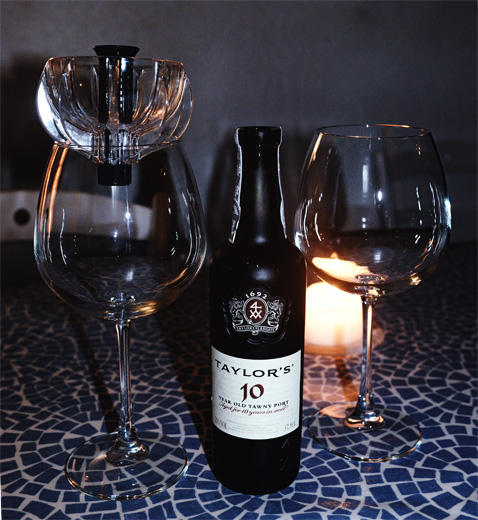Rating
Price
£24.99
What’s it supposed to do?
You pour your wine through the WineWeaver (which sits on top of your wine glass/decanter) and through the process of aeration, the wine should taste better.
The Verdict
It does indeed change the taste. Usually, but not always for the better.
More Info
http://www.wineweaver.com/

What’s the big deal about aeration?
Aeration was one of those things that I thought was basically wine mysticism bullshit, or the kind of stuff that only genetically gifted tasting freaks, or OCD sommeliers/masters of wine would actually notice.
Having been sent one to try, however, I have revised my opinion.
The idea?
Uncork a wine and wait an hour, or leave it for 5-10 minutes then aerate it for the same effect.
What is the effect? Allowing air to get to the wine – allowing oxidisation and evaporation to occur. It’s supposed to make it taste better.
If, like me and most people who grew up with DSL internet, you now have the patience of an ADHD labrador puppy, aeration seems like a good idea.
You want good taste, and you want it now.
Will the WineWeaver do the trick?
Initial Thoughts
Well, the plastic doesn’t look all that sturdy. I would have preferred glass or Pyrex, but OK.
No batteries or bullshit though, so once you’ve got it on your glass/decanter it’s kinda ‘set and forget’ – which again, goes with my inability to do too much at once.
It doesn’t add any complexity to your life or your wine drinking, once it’s sitting there you basically pour into it and drink what comes out underneath. Cleaning is straightforward, but don’t blast it with soap, unless you like your wine to taste like fucking soap.
Use
You’ll likely spend a little while trying to work out what bit your pour the wine into and where the wine comes out – and how to position it over your glass – though once you get that, the process is straightforward.
This can still be a bit of a pain though – you can’t pour too much, or it overspills, normally this is OK, but when you’ve had a few it becomes more of a challenge.
Again, with the multiple positions of the black spout in the middle that does the aerating, it takes a little time to work out how/why/which position you want it in. That said, I’ve had mine set on one setting since I got it
Pouring with it is somewhat rate limiting, you can’t pour too fast as it doesn’t have enough ‘holes’ to allow super fast aeration. it doesn’t take too long to filter through the spout, though there’s an initial adjustment period where you might want to pour too fas
The stand is also not sturdy feeling, but the cool thing is once you’ve aerated it, the drops of wine that haven’t all come out of the aerator collect in the stand, preventing that feeling of having ‘wasted’ any. Then, pour back into your mouth for maximum frugality/inebriation.
‘Field Testing’
Naturally the next step is to start pouring booze into it and see what happens. I try the following wines…
Wine 1: Sula Nasika Zinfandel
A relatively ‘weak’ zinfandel which I picked because who knew they grew Zinfandel in India? Wow…
Not bad…
Definitely mellowed it out, and the effect got better over time.
Verdict: Great! Seemed to make it taste more ’round’ and rich – definitely an improvement
Wine 2: Frei Estêvão Douro Colheita 2009

This is a quite rich and oaky wine that comes from the same area the port is made in. It’s also stupidly cheap, which I think is a pricing error somewhere in the supply chain.
The aeration takes creamyness out of it and kinda flattens the flavour profile. It also makes it a lot sharper/harsher on the nose (super great if you have a bit of a cold and want to burn a pathway into your sinuses with alcohol!).
After aeration, it’s become either too subtle for me or just boring.
Verdict: NO! Not much change to be honest, but makes it slightly less appealing
Wine 3: Valdepeñas Vega del Cega
Takes the edge off of this cheap dry red from LIDL, which might not necessarily be a good thing.
The wine didn’t have loads of body, so to lose the ‘front’ might not have been too much help.
That said, on my 2nd or 3rd comparison swill my palette seems to have ‘acclimatised’ (I think) and I actually preferred the smoother aerated taste more. Or it improved in 15 minutes, or both.
Verdict: Good!
Wine 4: Palomar Creek, Zinfandel Old Vine 2012
Current approach to life: If it says ‘Zinfandel’ on the bottle, and is more or less affordable, I will buy one to try. This is why my room looks like an off license. And, this is also how I end up with a bottle of Lidl’s £5 America Week promotional wine.
It is not a particularly good Zin, selling my favourite grape short. But I try it with the aerator anyway
I leave it to breathe for 10 minutes (in my mind I imagine the bottle hyperventilating, which makes me feel a pang of sympathy for this inanimate object…)
Comparing the aerated with the non aerated, the biggest change is in the smell. The aerated one now smells not very nice – that same sharpness of a bad white wine – almost going towards vingegary. Does this mean it got too much air? I don’t know.
The taste is a little different too – aerated tastes sharper – which I don’t like. What I like about Zinfandel wines is that, generally they’re big, warm and mellow – like a very tame Golden Retriever. Unaerated, this one is a bit boring, but when you aerate it, it goes from boring to NOT LEGIT.
So yes, aeration is working, but it makes an OK wine into a bad one here.
Verdict: No!
Wine 5: The Co Operative – Casablanca Valley Truly Irresistible Pinot Noir

The Coop‘s own take on Pinot Noir, this is one that I’d tried already and known to be good. Question was, I guess, could we make it better with aeration? Answer: Yes
Like with #1 & #2, aeration makes it smoother but retains it’s richness. It’s not a huge change but still noticable. Leaving it in the fridge for 15-20 minutes also improves the flavour. Delicious served chilled on a stifling hot day, it confirms my theory that there’s no occasion that can’t be improved with the addition of a strong new world wine.
Verdict: Well, it’s a moderate improvement – but worth investing the 2 minutes or so worth of aeration…
Wine 6: Taylor’s – 10 Year Old LBV Tawny Port
Taylor’s LBV is never not eyewateringly, ecstasy inspiringly good and so this test will be a matter of can I make it better still?
(Caveat: I do this one with a bit of a cold)
Aerated: more strong sharp smell. Subtly slightly sharper on the tongue, possibly psychosomatic based on what i have smelt non aerated is sweeter and more simple
Verdict: Aerated is slightly more complex, allowing some of the richness to cut through the sweetness Yes!

Verdict
So we have established that aeration is not bullshit, and that the WineWeaver, more often than not, will improve what you pour into it.
This was not the most scientific testing (for that I should probably have done it double blind in a controlled environment, with the same people, same temperature, same food pairings..you get the drift).
However, everybody agrees that generally the taste changes, and usually for the better…
It definitely does what it says on the tin (despite coming in a box and not saying what it does on the box), so I guess now I need to try various aerators and compare the results. In a lab or something. Whilst sober…
